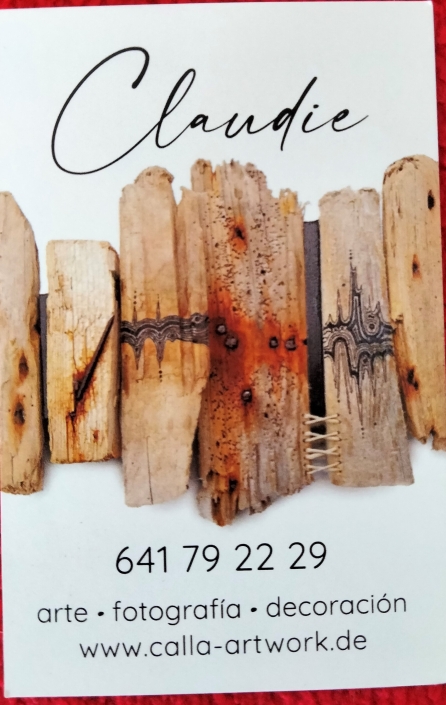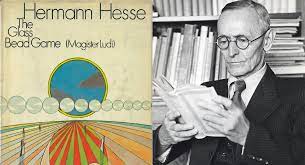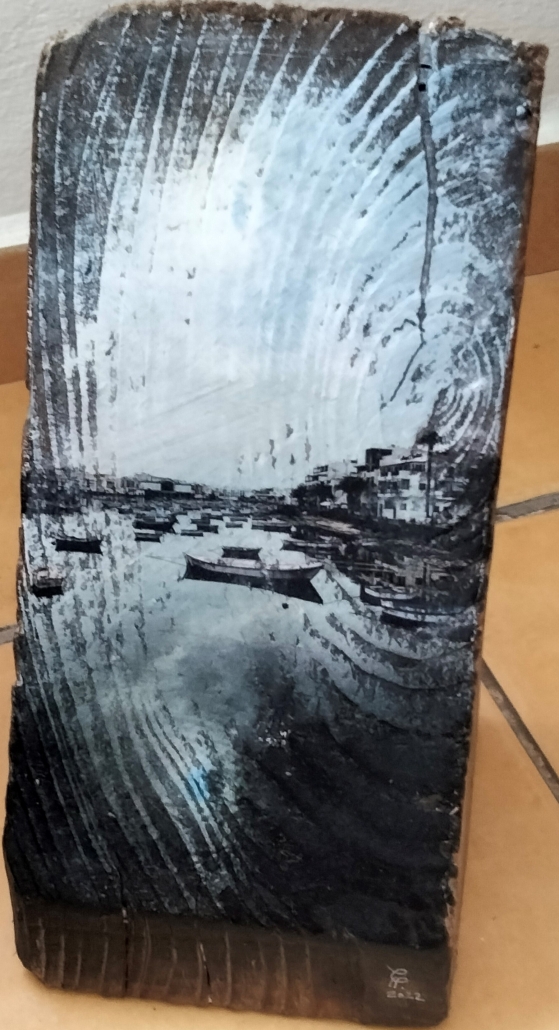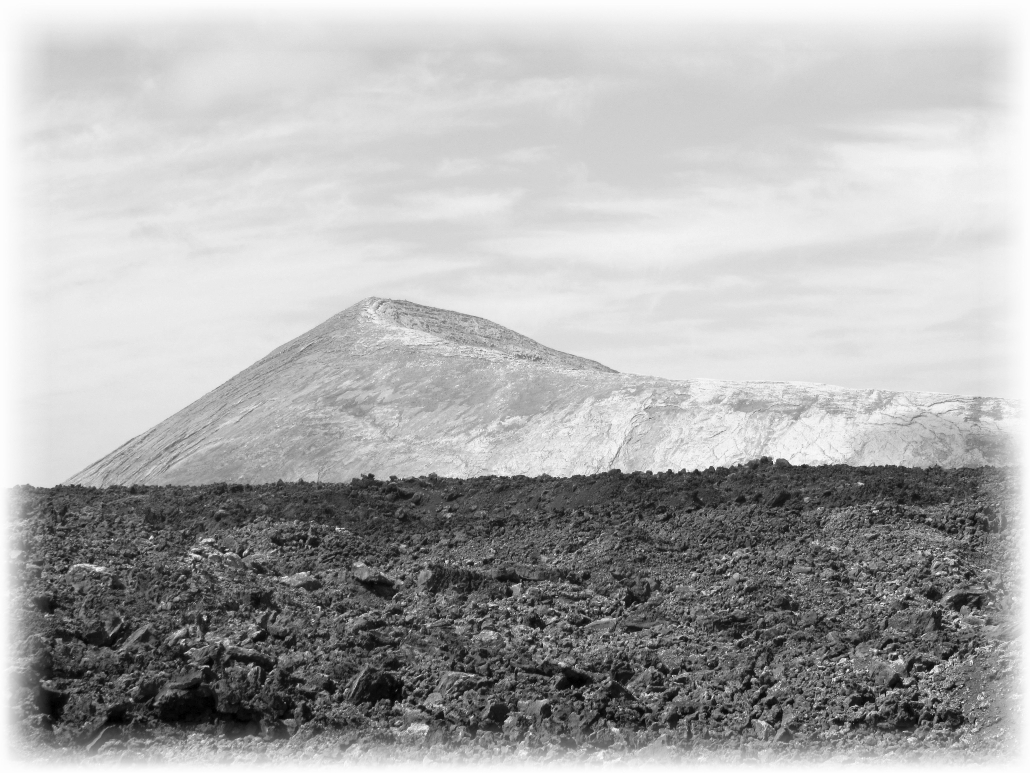COMMUNICATING WITH CLAUDIE about art
Norman Warwick
COMMUNICATING WITH CLAUDIE about art
We recently listened to ARTists ARTiculating ART in an article we published on 25th October 2002, that remains in our easy to negotiate archives of more than 750 pieces. Our interviewees included Adriyana Hodge, a photographer then showing a collection called The Secret Places Of Lanzarote, at Julio´s Tap Room Bar in Costa Teguise, that will run until the end of November. If you are in Costa Teguise any time this month we are confident you would find a visit very interesting.

In that same post we also interviewed Marie Cristine Carayon, (shown left with art works by Claudie) a great friend of the arts here on Lanzarote who was at the time care-taking an exhibition in La Ermita by Claudie Huppe. We hadn´t been able to conduct any interview with Claudie on the day of the inauguration, so crowded was the beautiful church was scores of large abstract, often geometric, paintings and a number of beautiful landscapes painted on driftwood collected by the artist.
Nevertheless, thanks to great deal of help from Cristine we were able to set up an internet interview with Claudie Huppe that told us quite a bit about her working life as an artist on Lanzarote. We include it here in full with a link to her web site as we are sure many readers will want to see more of her art work.

WHO do you recognise as Claudie the artist ?
In my youth and earlier days of my career I always wondered from what point on may I actually call myself an artist. How sucessful do I have to be and how much recognition do I have to earn before I dare to say: „I am an artist“? I thought it is a definition by those who look and judge my art. – Today I think differently. For me there is no distinction between Claudie the person and Claudie the artist anymore. And maybe there never was. I just gained a confidence over the years which I did not have then. From the minute I open my eyes in the morning (and even when I dream at night) I am aware of the magic concepts of art around us. For example, a walk at the beach is like a stroll trough an exhibition. Patterns left in the sand by the sea, the form waves take in each single drop they are made of, just look at the traces animals leave in the sand … I notice it everywhere, in nature and in life and I love to make others see it too. So „Claudie the artist“ is the creativity within myself on which I live my life by and it is impossible switch it off. No matter if I work as a photographer, create new designs for a magazine, write, paint or draw or even work in the garden. It is always there. I cannot NOT be an artist anymore.
WHO do you think those of your viewers who don´t know you might imagine is the artist?
To be honest, I do not think I can demand from any viewer of my art to imagine who I am. If I can give them an emotion I am happy enough. With a little luck they might even notice that I am a person with a knack for aesthetics. I love to make something extraordinary out of something ordinary. Especially when working with driftwood or old materials I can live this particularly strongly. In my tidal art for example, I unite half rotten wood with my photos and hand-painting. In this interaction – like in a perfect marriage – the characters of both partners are enhanced but together they build something new and beautiful as well. In high school my art teacher once said something funny. He told me I would even turn a pile of trash into something beautiful when I paint it. I am not sure if this really was a compliment but I take it like that.
In WHAT way does public response to a work affect the piece?
I think this depends very much on the form of art and the person who created it. Let‘s take the music business. Recognition and the position in the charts seems to be synonymous with success. The more you sell, the higher your rank the more successful you are. – If you create a piece of art and the recognition is high, maybe you sell it quickly. This feels good and it pays your rent. It might be tempting to create something very similar and try to succeed again. But does this really work? And does it make you happy? It might in some more decoratively focused techniques, but generally I doubt it. – I like to think that the response of the public spices the art and the art is like salt and pepper to the public. I feel an inner compulsion to show the world in my eyes with my art. If you like my work, it makes me happy. If you don’t like my art I might not be so happy but it’s still interesting. Either way, your reaction will be a welcome spice in my kitchen.
in WHAT way does public reaction to a piece or a collection affect the artist?
Like salt and pepper … see above.
WHEN travelling through time and space, does a work of art fall in and out of relevance?

The idea to visit the past has always been fascinating to me. In my dreams I have already travelled in this manner to the middle-ages, been in Rome with Cesar and when Edward Munch painted The Scream (left) I looked over his shoulder. What did he feel when he was painting? But what is the relevance of a piece of art concerning time? We lack the emotional experience of that time. We know maybe that some techniques were invented, a style was suddenly developed, maybe we know fragments of the life of the artist but we do not know anything about the fundamental truths or the life or an era personally. All we have is assumption and logic to presume relevance in past times. What we can say is how relevant a painting is for us here and today. For me art has a strong emotional or intellectual impact and that happens all the time when you look at it. So maybe art never falls out of relevance as long as it is.
WHEN the history of the creator become tarnished, (as Hitler, let´s say) should the art work then be judged to be tarnished too?
This is a difficult question. And Hitler is always a very strong example but I will try to answer it. Works can stand for their own and if you see a great piece of art and you like it without knowing that it was made by a murderer it only is a beautiful masterpiece. If you like to have it in your living room you go for it. But now somebody tells you it was painted by Hitler. What happens? You probably do not see the painting anymore, you see the person behind it and all of a sudden in the structure the pencil left on the canvas you read evil.

My great mentor was photographer Jochen Blume, who died some years ago at the age of 94.
editor´s note Prof. Jochen Blume (1925-2018) is known for his exceptional talent of capturing the perfect moment. He worked for renowned Magazines and was able to shoot some of the most famous personalities like Sophia Loren, J.F. Kennedy, Fidel Castro and more. His photographs of historic moments went around the world and still impress und influence us all. Now the last originally signed pieces are exhibited at our Gallery – don’t miss your chance to get a look at these ageless classics!
He actually lived during Hitler times and always said „if they would not have kicked him out of art school, everything could have been different“ … So if you really had a piece of art of Hitler it would have been from his youth when he was still quite an average man. But back to the question. I think it is not possible to answer this question with: it should or should not. It is more about what happens to you personally being in the knowledge of that. I once experienced an art becoming tarnished for me, to be more specific: cinematographic art. I used to like films with a certain actor until I read repeatedly bad stuff about him: ultra conservative, misogynistic, racial, sometimes violent to name only some of his characteristics. From that moment on it did not feel right to continue watching his movies and for 20 years I have not watched one again. Hundreds of people are in a film team and he was only the protagonist but still … it just did not feel right. From the second I knew about his manners it felt as if I would quietly support him and his actions if I go on watching his movies. It was a purely emotional decision and is neither a recommendation nor a rule to me, it just felt right.
WHERE, figuratively, do does art take you mentally when engrossed in a project?

To answer this I would like to quote a man I have admired since my childhood „Hermann Hesse. (left) He was a poet, journalist and painter and had a principle for his life, which I find very true: „be in the world but don`t be of the world.
When I am in a working process I completely leave the planet. My art is me and I am my art. I am no person any longer, have no thoughts or troubles anymore. I become the paint, the pencil, the art. It is pure bliss. Maybe like being in the perfect relationship but your partner is a better version of yourself. I feel completely in balance with myself, dive into my own endless ocean and when I come back to the surface I am wiser, happier and super content. Does that sound like a deprivation tank experience? Ha ha … I do not know but it is true, weightless floating.
WHY do some people suggest that art cannot exist in isolation?

I think there are different types of isolation. Each one can have a different impact on creative work. I guess the general assumption is that loneliness often leads to great works of art. When you move yourself from the turbulences of society its easier to push open the door of your mental studio and transform artistic ideas into art objects. I personally agree and there are many artists who fully withdrew from everything and focused on their work in isolation. Pollock and Kresner, Munch, Goya, Edward Hopper (right) and many more.
– But once the art is done where does it go? Do we keep it on our own walls, hidden from any other eye? Don‘t we need to step out of our studios and show it to get a responce? I think we do. So from that moment on another creative process begins. The one we talked about in your third question „how public reaction effects the art“. – Then there is another kind of isolation. The idea of using your art as part of a big puzzle, like working together with other artists and make a new, even bigger art of many small art pieces. I‘m not talking about a group exhibition and I am not really convinced of art concepts where different artists throw their finished works together, like an artistic hot pot, to see what the outcome will taste like. But I like the concept to bring arts together, which do not necessarily match at first sight. An example. In Hamburg in the late 80s „Peter Zadek“ the director of a the grand German theater „Deutsches Schauspielhaus“ brought the experimental music group „Einstürzende Neubauten“ on stage to perform in a play called „Andi“. It was drastic, chaotic creativity as they use iron drums, engine blocks and really weird stuff to create a wild sound. They were integrated in the play and the action was musically amplified by this. No visitor had expected what came out of this and the opinios highly polarized. I loved it! If you bring – with a lot of respect one art for for the other – contradictory arts together then very, very interesting things can happen.

WHY does some art look better, perhaps, in a non-traditional gallery?
I am not sure that it does. For me a gallery is a space where the artwork is presented in the best possible way without much distraction around it so it can work its magic. But what is a non traditional gallery, does it work differently? I have been to exhibitions which took place in the woods, an abandoned industrial area, a tunnel under the river Elbe, a skyscrapers roof and such. But to be honest, all these locations drew so much attention away from the art. It was great to be there, enjoy the stunning atmosphere of the location but … all this was more important than the art itself. It is hard to imagine that any artist would want this. Unless the art itself is not so great or needs a spectacular location to draw enough attention. If an emerging artist needs a big bang exhibition to wake up the press and potential buyers a location like that could be a suitable stylistic device. Then I would definitely invite the band „Einstürzende Neubauten“ to make sure to be the talk of the town ha ha ha … If this is the case, put me on the list please!

We at Sidetracks And Detours were so impressed by Claudie´s exhibition in Playa Blanca that we returned on a couple of occasions to have a chat with Cristine, and we even purchased on of the pieces to lend some calm to the usual chaos of the office. The piece is a land / seascape of just about our favourite view on the island. The work (right) reminds me of looking over the lagoon at San Gines, beneath a hazy, silver sun and noting the splendid names given to the fishing boats.. The first I spotted was Lady Caterina´s Daughter and after counting several of similar quality I wrote Sixteen On The Water.
These day´s whenever I am foaming at the mouth and four-letter wording because a photograph won´t download, or everything on my screen is coming up in block capitals, or because I can´t find a file and when I do I find I have mis-named it and even worse I then find that my wife was right and I was wr,…wro…. no I can´t say it, but even in those strenuous circumstances the image created by Claudie has a soothing influence.


I am not sure that another forthcoming event on the Lanzarote calendar will be quite as soothing, but it certainly sounds interesting. Our friend and reader Sigrid Baun Umbrech, who held a successful art exhibition ot the same venue only last week, has now made us aware that on Sunday, November 13th at 7 pm at the Centro de Terapia Antroposófica, Calle Salinas 12, Puerto del Carmen (hall), the author, clown, cabaret artist EVA PAULA PICK (left) will once again create an eventful evening. Anyone who has ever experienced Eva will certainly remember her performance well.
This time she is delivering a piece called LAPIDOSA which looks at the neighbouring islands of La Graciosa and Lanzarote from a literary point of view. Eva will perform selections from her stories and sound poems.
Admission is free.

There may also be available on the evening some of the few copies remaing of Sigrid´s limited edition Lanzarote 2023 calendars.
Each month´s page carries a Lanzarote scene.
The photographs I have seen certainly reflect Sigrid´s artistic eye, and there is a certain majestic stillness to her work.
iThat stillness anbd vastness and emptiness is captured her photograph shown right of a mountain horizon against the skyline.
Only 30 copies of the calendar have been produced but there might still be a few left of the signed-by-the-artist limited collection




Leave a Reply
Want to join the discussion?Feel free to contribute!